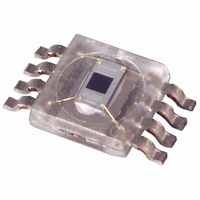LX1993CDU Microsemi Analog Mixed Signal Group, LX1993CDU Datasheet - Page 6

LX1993CDU
Manufacturer Part Number
LX1993CDU
Description
IC LED DRVR WT/CLR BCKLGT 8-MSOP
Manufacturer
Microsemi Analog Mixed Signal Group
Type
Backlight, White LED, Color LEDr
Datasheet
1.LX1993CDU.pdf
(12 pages)
Specifications of LX1993CDU
Constant Current
Yes
Topology
PWM, Step-Up (Boost)
Number Of Outputs
1
Internal Driver
Yes
Type - Primary
Backlight
Type - Secondary
Color, White LED
Voltage - Supply
1.6 V ~ 6 V
Mounting Type
Surface Mount
Package / Case
8-MSOP, Micro8™, 8-uMAX, 8-uSOP,
Operating Temperature
0°C ~ 70°C
Current - Output / Channel
300mA
Internal Switch(s)
Yes
Efficiency
80%
Lead Free Status / RoHS Status
Lead free / RoHS Compliant
Voltage - Output
-
Frequency
-
Copyright © 2000
Rev. 1.0b, 2005-03-03
Therefore ,
D
The output overshoot can be estimated as follows where the
0.5 value in the denominator is an estimate of the voltage
drop across the diode:
D
equals 13.0mA, L equals 47µH, C
equals 3.0V, and V
(e.g., Microsemi UPS5817). The low forward voltage drop
and fast recovery time associated with this device supports
the switching demands associated with this circuit
topology. The designer is encouraged to consider the
diode’s average and peak current ratings with respect to the
application’s
requirements.
voltage characteristic must be capable of withstanding a
negative voltage transition that is greater than V
PCB L
current waveforms hence; the designer should take this into
consideration when laying out the circuit.
trace lengths from the IC to the inductor, diode, input and
output capacitors, and feedback connection (i.e., pin 3) are
typical considerations. Moreover, the designer should
maximize the DC input and output trace widths to
accommodate peak current levels associated with this
topology.
IODE
ESIGN
A Schottky diode is recommended for most applications
The LX1993 produces high slew-rate voltage and
∆V
∆V
Determine the V
DROOP
OVERSHOOT
S
AYOUT
ELECTION
∆V
E
V
I N T E G R A T E D
∆V
XAMPLE
DROOP
RIPPLE
=
OVERSHOOT
⎛
⎜ ⎜
⎝
4.7
47
=
output
Further, the diode’s reverse breakdown
µ
=
= 2.0mV + 18.4mV + 10mV = 30.4mV
µ
1
:
H
2
F
OUT
⎛
⎜ ⎜
⎝
×
⎞
⎟ ⎟
⎠
C
⎛
⎜ ⎜
⎝
RIPPLE
×
11861 Western Avenue, Garden Grove, CA. 92841, 714-898-8121, Fax: 714-893-2570
(
13.0
4.7
=
47
OUT
equals 13.0V:
L
(
200mA
1
µ
µ
2
and
(
(
H
13
×
F
V
−
⎞
⎟ ⎟
⎠
IN
⎛
⎜
⎜
⎝
where I
⎞
⎟ ⎟
⎠
0.5
×
(
0 .
V
×
C
(
−
OUT
+
×
(
OUT
I
L
)
200
PK
2 1
0.5
0.5
peak
+
8 .
⎞
⎟
⎟
⎠
P R O D U C T S
mA
×
)
−
PK
×
0.5
mA
OUT
I
3
(
OUT
I
0 .
equals 200mA, I
−
PK
−
)
A P P L I C A T I O N I N F O R M A T I O N
)
12
inductor
V
equals 4.7µF, V
≅
−
)
IN
8 .
2
I
0 .
OUT
mA
)
mV
)
)
Minimizing
Integrated Products Division
OUT
2
2
≅
.
18
current
Microsemi
4 .
mV
OUT
IN
E
Microsemi for assessing overall circuit performance. The
evaluation board, shown in Figure 3, is 3 by 3 inches (i.e.,
7.6 by 7.6cm) square and programmed to drive 2 to 4 LEDs
(provided). Designers can easily modify circuit parameters
to suit their particular application by replacing R
described in this section) R
Moreover, the inductor, FET, and switching diode are easily
swapped out to promote design verification of a circuit that
maximizes efficiency and minimizes cost for a specific
application.
connections are described in Table 1.
however the LX1993 IC may be driven from a separate DC
source via the VCC input. The output current (i.e., LED
brightness) is controlled by adjusting the on-board
potentiometer.
brightness adjustment circuit from VBAT or via a separate
voltage source by selecting the appropriate jumper position
(see Table 2). Optional external adjustment of the output
LED current is achieved by disengaging the potentiometer
and applying either a DC voltage or a PWM-type signal to
the VADJ input. The PWM signal frequency should be
higher than 150KHz and contain a DC component less than
350mV.
typ) during shutdown mode. The SHDN pin is used to
exercise the shutdown function on the evaluation board.
This pin is pulled-up to VCC via a 10KΩ resistor.
Grounding the SHDN pin shuts down the IC (not the circuit
output). The output voltage (i.e., voltage across the LED
string) is readily measured at the VOUT terminal and LED
current is derived from measuring the voltage at the VFDBK
pin and dividing this value by 15Ω (i.e., R4). The factory
installed component list for this must-have design tool is
provided in Table 3 and the schematic is shown in Figure 4.
Efficiency Measurement Hint: When doing an efficiency
evaluation using the LX1993 Evaluation Board, VPOT
should be driven by a separate voltage supply to account for
losses associated with the onboard reference (i.e., the 1.25V
shunt regulator and 1KΩ resistor). This circuit will have
VBAT - 1.25V across it and at the higher input voltages the
1KΩ resistor could have as much as 4mA through it. This
shunt regulator circuitry will adversely effect the overall
efficiency measurement.
application; hence, it should not be considered when
measuring efficiency.
VALUATION
The LXE1993 evaluation board is available from
The DC input voltage is applied to VBAT (not VCC)
The LX1993 exhibits a low quiescent current (I
High Efficiency LED Driver
B
OARD
The evaluation board input and output
The designer may elect to drive the
P
RODUCTION
It is not normally used in an
SET
(i.e., R4) and LED load.
Q
LX1993
< 0.5µA:
CS
(as
Page 6






















